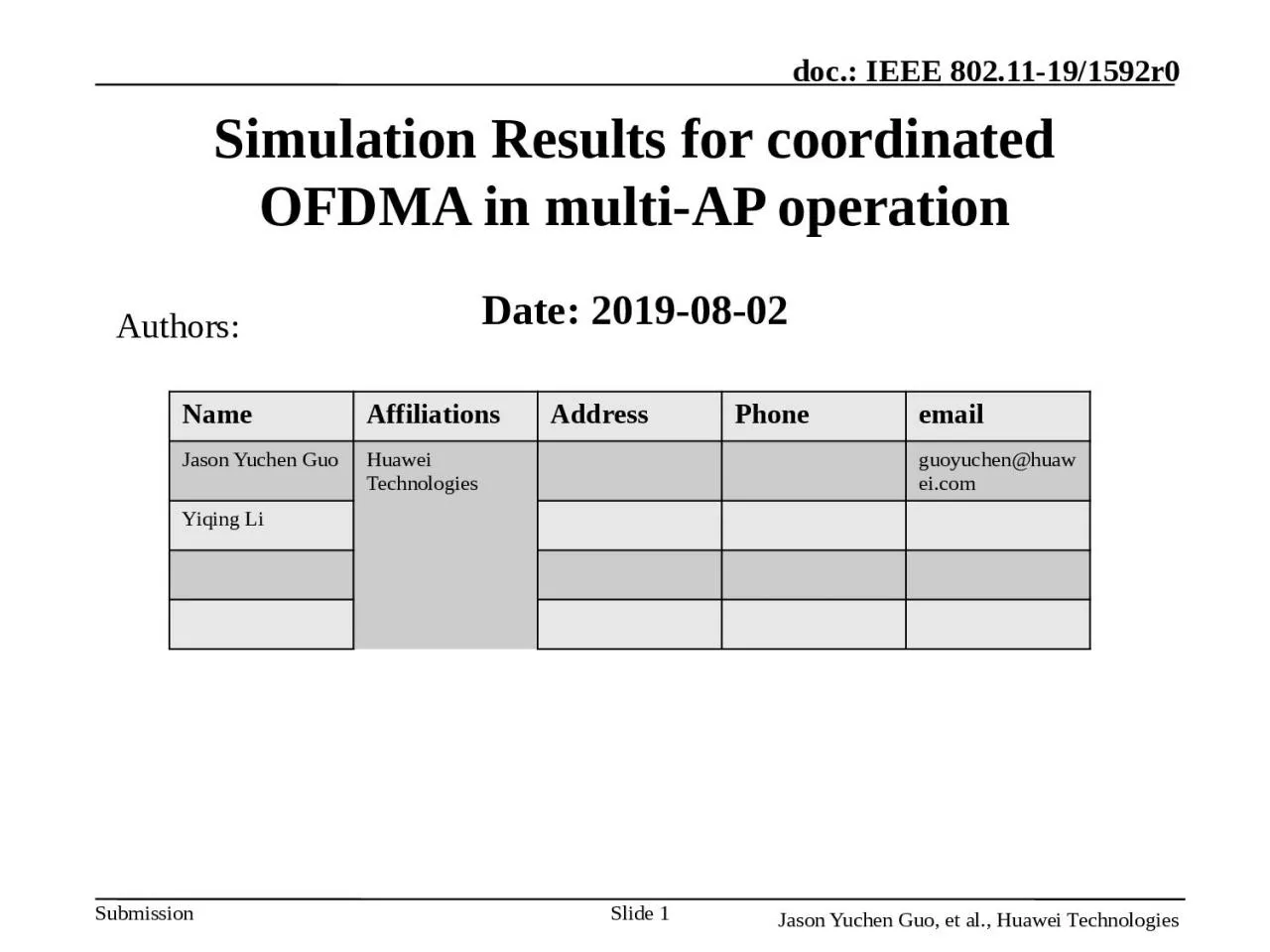

multiAP operation Date 20190802 Slide 1 Authors Name Affiliations Address Phone email Jason Yuchen Guo Huawei Technologies guoyuchenhuaweicom Yiqing Li Introduction Slide ID: 918950
Download Presentation The PPT/PDF document "Simulation Results for coordinated OFDMA..." is the property of its rightful owner. Permission is granted to download and print the materials on this web site for personal, non-commercial use only, and to display it on your personal computer provided you do not modify the materials and that you retain all copyright notices contained in the materials. By downloading content from our website, you accept the terms of this agreement.
Slide1
Simulation Results for coordinated OFDMA in multi-AP operation
Date: 2019-08-02
Slide 1
Authors:
Name
Affiliations
Address
Phone
email
Jason Yuchen Guo
Huawei Technologies
guoyuchen@huawei.com
Yiqing
Li
Slide2Introduction
Slide 2
Multi-AP operation is considered as a major candidate feature for 802.11be
[1].There are four modes of Multi-AP operation that are under discussion in EHT SG and TGbe:Coordinated BF [2][3][5][7][8]Coordinated OFDMA [2][3][8]
Coordinated SR [4][9]
Joint transmission [2][3][5][6][10][11]
Among the four modes,
Coordinated OFDMA has been proposed
without simulation results, while other three modes are demonstrated by simulation results to show performance gain in different scenarios
[4-11
].
In this contribution, we evaluate the performance of coordinated OFDMA by system level simulation results.
Slide3Simulation Scenario
Slide 3
We consider a two-BSS scenario (e.g., home environment), where two APs are 20 meters away from each other.
In each BSS, there is one STA randomly placed in the coverage range of each AP.Total bandwidth: 160MHzPacket size: 1500bytes
A-MPDU: 64 (Maximum)
MCS: 9
Nsts
: 1
Slide4Simulation Scenario
Slide 4
Traffic Model: Burst traffic
Packets arrive in the form of bursts, for each burst, there are 400 packetsPackets are assumed to arrive at the beginning of each burst, all arrive at the same timeThe traffic data rate affects the burst interval: the higher traffic data rate, the shorter burst interval
…
Burst 1
…
Burst 2
…
Burst 3
……
Burst interval
……
…
Burst 4
Performance Metric: Burst throughput
Burst
throughput = Number of bits in a burst / (T1 – T0)
T0 is the time that the first bit of the burst comes into the buffer
T1 is the time that the whole burst is transmitted successfully
We simulate 150 bursts, and calculate the average burst throughput as the performance metric
Delay (T1 – T0) is also used as a performance metric
Slide5Transmission Procedure
Slide
5
Coordinated OFDMATwo APs share the whole 160MHz bandwidthTwo APs stay on the same primary channel, and contend to access the channel using EDCA.When the
backoff
counter reaches zero, each AP will do the following
With probability p, the AP will send a slave trigger frame to the other AP to initiate co-OFDMA transmission, where each AP can use 80MHz to do the data transmission
With probability 1-p, the AP will use the whole 160MHz channel to do the data transmission
Baseline
Two APs will use two different 80MHz channels for data transmissions
The two 80MHz channels are non-overlapping with each other
Coordinated OFDMA
BaselineProsDynamic bandwidthDedicated channelNo collisionConsCollision may happen
Slave TF overheadMaximum bandwidth is limited
Slide6Simulation Results
Slide 6
When traffic data rate is low, co-OFDMA has a wide dynamic range of burst throughput, depending on the probability of using co-OFDMA
When co-OFDMA is not used, each AP can occupy the whole 160MHz, making it faster to finish the transmission of a burstWhen traffic data rate is high, using baseline is slightly better, since the packet loss rate is lower, but there’s not much different between all the schemesIn conclusion,
using co-OFDMA with lower probability is better
Slide7Simulation Results
Slide
7
Delay is a direct transform of burst throughputUnder low traffic data rate, using co-OFDMA with lower probability can provide better delay performance, because using wider bandwidth can reduce the delay significantly;
Under high
traffic data
rate,
baseline is slightly better, but there are not much difference
among all
the schemes.
Slide8Conclusion
Slide 8
We evaluate the performance of co-OFDMA by system level simulation results in home environment.
The results show that using co-OFDMA with higher probability does not provide much performance gain regarding burst throughput and latency, conversely, using co-OFDMA with lower probability is better.It is encouraged for people to do more simulation on co-OFDMA to show the performance gain.
Slide9Reference
[1] 11-18-1231-06-0eht-eht-draft-proposed-par[2] 11-18-1576-01-0eht-considerations-on-ap-coordination
[3] 11-18-1509-00-0eht-features-for-multi-ap-coordination[4] 11-19-801-00-0eht-ap-coordination-in-eht[5] 11-18-1510-01-0eht-ap-coordinated-beamforming-for-eht
[6] 11-19-0800-00-00be-joint-processing-mu-mimo-update[7] 11-19-0638-00-00be-nulling-and-coordinated-beamforming[8] 11-18-1155-01-0eht-Multi-AP Enhancement and Multi-Band Operations[9]
11-19-0071-00-0eht-
Coordinated Multi-AP Transmission for EHT
[10] 11-19-0763-00-00be-measurements-for-distributed-mu-mimo
[
11]
11-19-0779-01-00be-performance-investigation-on-multi-ap-transmission
Slide 92018